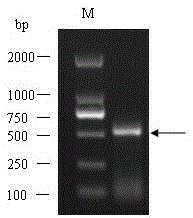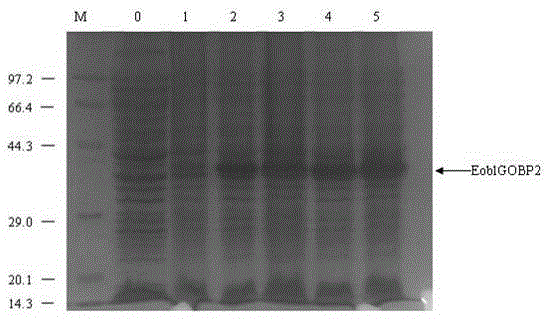A screening method for plant-derived attractants based on tea geometrid odor-binding protein
A technology of odor binding protein and screening method, applied in the field of screening of plant-derived attractants, can solve problems such as difficult to effectively design and develop, complex volatile components of tea tree leaves, etc.
- Summary
- Abstract
- Description
- Claims
- Application Information
AI Technical Summary
Problems solved by technology
Method used
Image
Examples
Embodiment 1
[0024] 1) Specific steps for collecting total RNA from the antennae of the tea geometrid;
[0025] Materials: Tea geometrid larvae were captured in Hangzhou tea gardens, and artificially reared to adults in the laboratory for experimental use. Larva rearing conditions are: temperature 26±1°C, L:D=12:12, RH 70%-80%. Total RNA was extracted from the antennae of adult tea geometrids by TRIzol method, and the first strand of cDNA was obtained by reverse transcription using Super-Script?ⅡReverse Transcriptase System (Takara).
[0026] 2) The specific steps of obtaining the full length of the tea looper odor binding protein by RT-PCR;
[0027] ① Design of primers for tea geometrid EoblGOBP2. According to the gene sequence of the tea geometrid common odor binding protein GOBP2 (EoblGOBP2) in Genbank (Genbank accession number is: ACN29681.1 (12), primers were designed using PrimerPremier5.0 software. For the convenience of later expression, the target gene was cloned into the expres...
Embodiment 2
[0052] Tests demonstrating the effectiveness of the botanical attractant obtained by the present invention.
[0053] 1) Insects to be tested. The mature larvae of Tea Geometrid were collected from the artificially reared population in this laboratory. The feeding conditions are: temperature (26±1)°C, relative humidity (75±5)%, photoperiod L:D=12:12 (light 12h, dark 12h). After pupation and eclosion, the sexually mature adults were collected for experiments, and they were starved for 3 hours before the experiments.
[0054] 2) Experimental instruments and reagents. The experimental instrument used the antenna potentiometer (Netherlands Syntech Company); various standard volatiles of tea tree leaves were purchased from Bailingwei, and each compound was dissolved in liquid paraffin, and made into a 0.1 (v / v) solution for EAG determination. Add 10uL of the sample solution to be tested dropwise on the filter paper strip (2cm×0.5cm) in advance, let the solvent volatilize for a wh...
PUM
 Login to View More
Login to View More Abstract
Description
Claims
Application Information
 Login to View More
Login to View More - R&D
- Intellectual Property
- Life Sciences
- Materials
- Tech Scout
- Unparalleled Data Quality
- Higher Quality Content
- 60% Fewer Hallucinations
Browse by: Latest US Patents, China's latest patents, Technical Efficacy Thesaurus, Application Domain, Technology Topic, Popular Technical Reports.
© 2025 PatSnap. All rights reserved.Legal|Privacy policy|Modern Slavery Act Transparency Statement|Sitemap|About US| Contact US: help@patsnap.com



